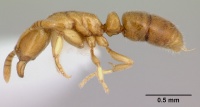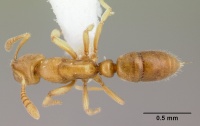Hypoponera coeca
| Hypoponera coeca | |
|---|---|

| |
| Scientific classification | |
| Kingdom: | Animalia |
| Phylum: | Arthropoda |
| Class: | Insecta |
| Order: | Hymenoptera |
| Family: | Formicidae |
| Subfamily: | Ponerinae |
| Tribe: | Ponerini |
| Genus: | Hypoponera |
| Species: | H. coeca |
| Binomial name | |
| Hypoponera coeca (Santschi, 1914) | |
| Synonyms | |
| |
Typically found in rainforest, either in litter samples or in rotten wood on the forest floor. Beyond this little is known about the biology of Hypoponera coeca.
Identification
Within the limits of the description (see below), Hypoponera coeca is a small, yellow species that is very widespread and quite common in samples of leaf litter and rotten wood across wide areas of sub-Saharan Africa.
A member of the abeillei group.
Keys including this Species
Distribution
Latitudinal Distribution Pattern
Latitudinal Range: 10.64° to -29.331105°.
| North Temperate |
North Subtropical |
Tropical | South Subtropical |
South Temperate |
- Source: AntMaps
Distribution based on Regional Taxon Lists
Afrotropical Region: Angola, Cameroun (type locality), Central African Republic, Congo, Gabon, Ghana, Guinea, Ivory Coast, Kenya, Nigeria, South Africa, Togo, Uganda, United Republic of Tanzania.
Distribution based on AntMaps
Distribution based on AntWeb specimens
Check data from AntWeb
Countries Occupied
| Number of countries occupied by this species based on AntWiki Regional Taxon Lists. In general, fewer countries occupied indicates a narrower range, while more countries indicates a more widespread species. |

|
Estimated Abundance
| Relative abundance based on number of AntMaps records per species (this species within the purple bar). Fewer records (to the left) indicates a less abundant/encountered species while more records (to the right) indicates more abundant/encountered species. |

|
Biology
Castes
Nomenclature
The following information is derived from Barry Bolton's Online Catalogue of the Ants of the World.
- coeca. Ponera coeca Santschi, 1914d: 322, fig. 9 (w.q.) CAMEROUN. Combination in P. (Hypoponera): Santschi, 1938b: 79; in Hypoponera: Bolton, 1995b: 213. Senior synonym of myrmicariae: Bolton & Fisher, 2011: 34.
- myrmicariae. Ponera myrmicariae Wasmann, 1918b: 144 (w.) CAMEROUN. Combination in P. (Hypoponera): Santschi, 1938b: 79; in Hypoponera: Bolton, 1995b: 215. Junior synonym of coeca: Bolton & Fisher, 2011: 35.
Unless otherwise noted the text for the remainder of this section is reported from the publication that includes the original description.
Bolton and Fisher (2011) - As with its very close relatives Hypoponera camerunensis and Hypoponera inaudax, the present concept of coeca may conceal more than one real species, but these currently defy analysis. Different samples show subtle variations in the shape and size of the petiole node. Some have the node slightly longer, higher or broader than others, some have the petiole dorsum more broadly convex than in others, some have the anterior and posterior surfaces more obviously convergent dorsally than in others and there is variation in the shape of the ventral process. In addition, although the vast majority of specimens completely lack eyes, extremely rarely a tiny eye-spot is discernible that at its greatest development is a single ommatidium, small and only partially pigmented. They are best developed in a short series in CASC from Gabon (Res. Monts Doudou, 19.iii.2000, numbers 2250, 2256 and 2258). Because they otherwise fit the above description, they have been retained within coeca for the time being.
Description
Worker
Bolton and Fisher (2011) - Measurements: HL 0.47–0.52, HW 0.37–0.42, HS 0.415–0.465, SL 0.30–0.35, PrW 0.26–0.32, WL 0.61–0.70, HFL 0.29–0.35, PeNL 0.13–0.17, PeH 0.25–0.31, PeNW 0.18–0.22, PeS 0.187–0.233 (75 measured). Indices: CI 77–84, SI 80–89, PeNI 63–77, LPeI 50–57, DPeI 125–150.
Eyes usually absent, extremely rarely a tiny eye-spot present (see below). In full-face view apex of scape, when laid straight back from its insertion, fails to reach the midpoint of the posterior margin; SL/HL 0.65–0.71. Funiculus distinctly with 5 enlarging apical segments. Metanotal groove usually entirely absent from dorsum of mesosoma but in some a vestige of its former path may be visible. Mesonotal-mesopleural suture absent from side of mesosoma or at most represented by an almost effaced faint line. Propodeal declivity separated from sides by bluntly rounded curves or blunt angles; without an acute raised sharp carina. Posterior surface of petiole node without short cuticular ridges that radiate from just above the peduncle. Node of petiole in profile short-nodiform, the anterior and posterior faces converge dorsally, usually obviously so; length of node just above anterior tubercle is noticeably greater than length of dorsum. Subpetiolar process conspicuously present in profile, somewhat variable in shape but always with a descending anterior face that terminates in a distinct ventral angle. Behind the angle the outline may slope evenly upwards posteriorly, but more usually there is a short, more steeply ascending portion of the margin immediately behind the angle; intermediate forms are known. Maximum width of first gastral tergite in dorsal view is noticeably less than width of second gastral tergite at its midlength. Sides of second gastral tergite shallowly convex in dorsal view. Midline length of second gastral posttergite, from posterior margin of cinctus to apex, is less than the maximum width of the segment. Cross-ribs at base of cinctus are short and crowded, but conspicuous. Disc of second gastral tergite with densely crowded, small, superficial punctures so that the surface appears microreticulate at lower magnifications. First and second gastral tergites dorsally pubescent and with a number of short standing setae that project just above the level of the pubescence. Full adult colour yellow.
Type Material
Bolton and Fisher (2011) - Syntype worker and queen, CAMEROUN: Victoria (F. Silvestri) (Naturhistorisches Museum, Basel) [not seen, presumed lost]. Neither of the original syntypes seems to have survived.
Ponera myrmicariae Syntype workers, CAMEROUN: Kamerunburg, Soppo, 730 m., xii.1912, “bei Myrmicaria eumenoides” (von Rothkirch) (Natuurhistorisch Museum) [examined].
References
- Bolton, B., Fisher, B.L. 2011. Taxonomy of Afrotropical and West Palaearctic ants of the ponerine genus Hypoponera Santschi. Zootaxa 2843: 1-118.
- Bolton, B. 1995b. A new general catalogue of the ants of the world. Cambridge, Mass.: Harvard University Press, 504 pp. (page 213, Combination in Hypoponera)
- Santschi, F. 1914d. Formicides de l'Afrique occidentale et australe du voyage de Mr. le Professeur F. Silvestri. Boll. Lab. Zool. Gen. Agrar. R. Sc. Super. Agric. 8: 309-385 (page 322, fig. 9, worker, queen described)
- Santschi, F. 1938b. Notes sur quelques Ponera Latr. Bull. Soc. Entomol. Fr. 43: 78-80 (page 79, Combination in P. (Hypoponera))
References based on Global Ant Biodiversity Informatics
- Bernard F. 1953. La réserve naturelle intégrale du Mt Nimba. XI. Hyménoptères Formicidae. Mémoires de l'Institut Français d'Afrique Noire 19: 165-270.
- Bolton B. and B. L. Fisher. 2011. Taxonomy of Afrotropical and West Palaearctic ants of the ponerine genus Hypoponera Santschi (Hymenoptera: Formicidae). Zootaxa 2843: 1-118
- Bolton, B., and B. L. Fisher. "Taxonomy of Afrotropical and West Palaearctic ants of the ponerine genus Hypoponera Santschi (Hymenoptera: Formicidae)." Zootaxa 2843 (2012): 1-118.
- Eidmann H. 1944. Die Ameisenfauna von Fernando Poo. 27. Beitrag zu den Ergebnissen der Westafrika-Expedition. Zool. Jahrb. Abt. Syst. Ökol. Geogr. Tiere 76: 413-490.
- Garcia F.H., Wiesel E. and Fischer G. 2013.The Ants of Kenya (Hymenoptera: Formicidae)Faunal Overview, First Species Checklist, Bibliography, Accounts for All Genera, and Discussion on Taxonomy and Zoogeography. Journal of East African Natural History, 101(2): 127-222
- Menozzi C. 1942. Formiche dell'isola Fernando Poo e del territorio del Rio Muni (Guinea Spagnola). 24. Beitrag zu den wissenschaftlichen Ergebnissen der Forschungsreise H. Eidmann nach Spanisch-Guinea 1939 bis 1940. Zoologischer Anzeiger 140: 164-182.
- Wheeler W. M. 1922. Ants of the American Museum Congo expedition. A contribution to the myrmecology of Africa. VIII. A synonymic list of the ants of the Ethiopian region. Bulletin of the American Museum of Natural History 45: 711-1004

